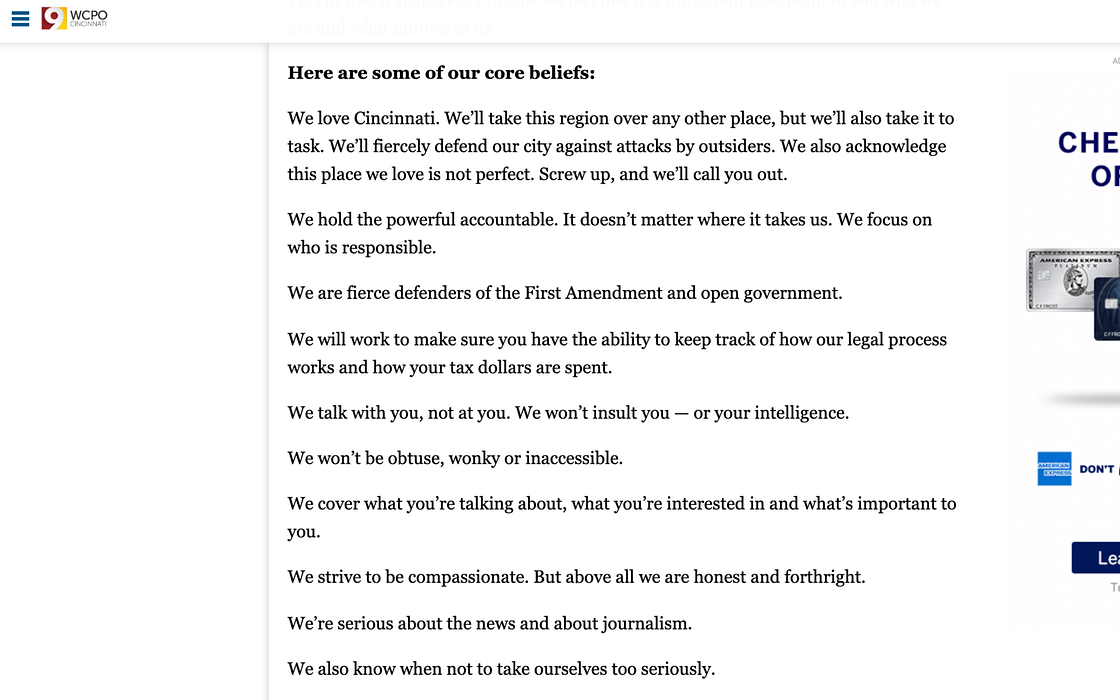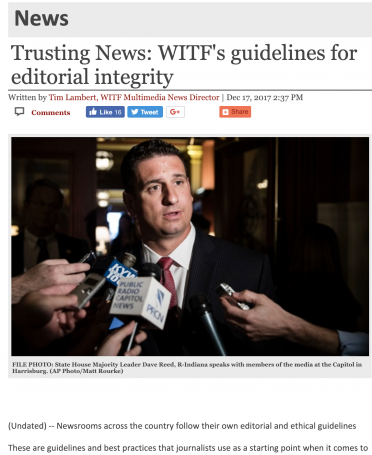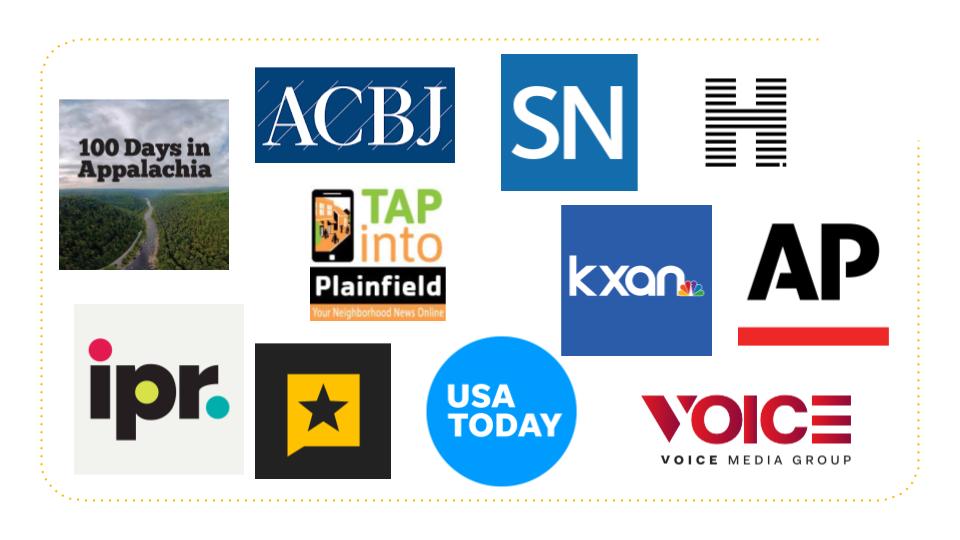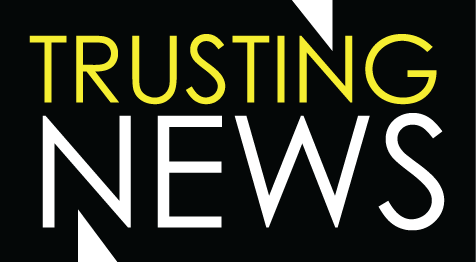
This step-by-step guide walks newsrooms through creating an effective “About us” page that will help them earn trust and demonstrate transparency.
Create an effective “About Us” page
What is your news outlet’s mission? What communities do you cover, and how long have you been in business? What do you value, and what are your standards? Who works in your newsroom, and how are they reachable? How do you make money?
These are all basic questions people might have about your news organization, but could they easily find the answers on your website, in your paper or on your social media profiles?
At Trusting News we find that a lot of newsrooms have information answering these questions somewhere, but it’s not always easy to find — and it’s almost always written using journalism jargon.
We want to help you answer these questions for your users and organize the information in a way that is easily accessible for them. Below, we walk you through the elements of a good “About Us” page so you can create one that works for you.
1. Do a content audit.
What information explaining who you are and what you value already exists? Think about any “About Us” pages that exist on social media or your website. What about a mission statement you publish in your paper? Do you have a “Contact Us” page? What information is listed there?
Gather all of the links, text and any audio or video clips that may exist and evaluate what you have. Is it all accurate? Does it need updating? Does it reflect the current values and mission of the newsroom?
When thinking about whether or not this content needs to be updated, think about who your audience for the content is. A lot of newsrooms have “About Us” pages or “Contact Us” pages that are heavy on the business side (how to advertise, share a circulation problem, etc.). That information is helpful, but not to users who just want to ask a question about a particular story, report a correction or submit a story idea.
The Corpus Christi Caller-Times recently updated a page on their website that answers a lot of these questions, including what their mission is, who owns the paper and how they handle corrections. (You can check out the page here.)
Some of the highlights from the page:
- They address how they make money by talking about their primary sources of revenue: advertising and subscriptions.
- They talk about who owns them and how their mission has stayed the same through ownership changes. “While the owners and location of the news organization has changed over the years, the mission has remained the same: to serve our community,” they wrote.
- They point out they have an ethics policy, link to the policy and highlight the main points (including talking about anonymous sources) in a way non-journalists would understand.

2. Share your history, mission and values
Writing your history
Telling your users how long you have been reporting on what’s happening in your community can be powerful. It can also help lend credibility to your organization. When talking about your history, be sure to focus on the impact you have had in the community instead of big-name hires or printing press changes. Consider writing about the big stories you’ve seen the community through. Include old pictures of the newsroom, your building, your front pages or your newscasts.
Think about including information like coverage area expansions or changes, the addition of new beats or the development of a podcast, video show, etc. Be sure to include any ownership changes, community event sponsorships and awards too.
If you don’t have a long history, that gives you extra opportunity to talk about when and why you were created and what purpose you serve. Newer organizations often have a clearer sense of what role they play in a community.
Sharing your mission & values
You probably already have a mission statement, and you definitely should share that. But be sure to also talk about what you value as a news organization. This goes beyond your mission to hold the powerful accountable or find the truth. Expand on that and talk about how you select which stories to cover and invest your resources in. That’s how your mission plays out day-to-day.
When WCPO revamped their “About Us” page, they highlighted their core beliefs and explained what being a journalist in their newsroom meant.
They discussed how they strive to be compassionate, how they will involve the community in their reporting process and that they love their community but still will highlight when something goes wrong.

3. Share your ethics and corrections policies
You most likely already have newsroom policies. You probably reviewed them during one of your first days on the job. Maybe you still refer to them while writing or editing a story or responding to a user complaint.
Newsroom policies often cover things like:
- Corrections and accuracy
- Financial independence
- Political independence
- Commitment to diversity
- Unnamed sources
- Photo and video editing and ethics
- Conflicts of interest
It’s important to have your policies clear internally. But, what if you also talked publicly about your ethics? What if you also explained when stories are corrected, how a user can tell if a story has been corrected, and how they can submit their own corrections?
If you’ve been following Trusting News, you have heard us say this before: Our users do not give us automatic credit for the ethical decisions we make — and do not assume that we strive to be consistent and fair. Rather than hope they’ll give us the benefit of the doubt (which they likely won’t), we have to explain ourselves.
So, let’s take our ethics policies and share them publicly. That might look different newsroom to newsroom. Here’s one example from WITF, one of our newsroom partners.

On this page, WITF explains how they attribute information to sources and vet information before publishing. They discuss how they work to be accurate, impartial and report information in context. They talk about how they choose what stories to cover.
Policies can also tell the story of your values, like this example does from our partners at the Atlanta Journal-Constitution. It includes things like:
- We treat people we write about fairly and openly. We work hard to avoid surprising anyone about what they may read about themselves in the AJC.
- We tread lightly into someone’s personal life and reveal no more than is absolutely necessary.
- We don’t pay sources for tips or story subjects for interviews. We don’t trade favorable coverage for any consideration including access.
4. Create a “Contact Us” page
Have you ever tried to get in touch with a journalist you did not know personally? We do it all the time. Unfortunately, many news organization websites are so hard to navigate or out of date that searching for the journalist on Twitter or Facebook is much easier. Your audience members won’t be as persistent as we are. Rather than continuing to dig, calling the newsroom or emailing a general email address, they will give up and move on.
Finding contact information for a news organization and for individual journalists should not be that complicated. All of us should have a “Contact Us” page that quickly explains how to submit a news tip or a correction request, and how to contact a department or an individual journalist.
When putting together a page like this, it’s great to create a one-stop-shop situation. Make it easy for people who come to accomplish a specific task by listing the general information first (news tip email address, correction form, etc.). Then have the staff bios with contact information below.
For staff bios, make sure everyone includes what their role in the newsroom and describes it without using jargon. But beyond that, they don’t all have to be the same. Some journalists may highlight different elements of their life or career depending on what they cover and what they feel comfortable with. And that is OK! The important thing is to give the users the information they’re looking for. They should come to this page and be able to find a specific person or learn who to contact for a specific purpose. It’s nice if they also learn something about how the organization is structured and how individuals fit in.
Some of our favorite examples of bio pages and other ways news organizations invite their communities to get to know them include:
- The Virginian-Pilot’s “Contact Us” page
- KPRC’s “Team” page
- The Christian Science Monitor’s “Monitor Staff” Instagram story
- KPCC/LAist’s reporter and producer mission statements
We hope you feel empowered to create a page or two that highlights who you are, what you do and how you do it. If you try any of these suggestions, please send them my way (Lynn@TrustingNews.org).
At Trusting News, we learn how people decide what news to trust and turn that knowledge into actionable strategies for journalists. We train and empower journalists to take responsibility for demonstrating credibility and actively earning trust through transparency and engagement. Subscribe to our Trust Tips newsletter. Follow us on Twitter and LinkedIn. Read more about our work at TrustingNews.org.

Assistant director Lynn Walsh (she/her) is an Emmy award-winning journalist who has worked in investigative journalism at the national level and locally in California, Ohio, Texas and Florida. She is the former Ethics Chair for the Society of Professional Journalists and a past national president for the organization. Based in San Diego, Lynn is also an adjunct professor and freelance journalist. She can be reached at lynn@TrustingNews.org and on Twitter @lwalsh.





